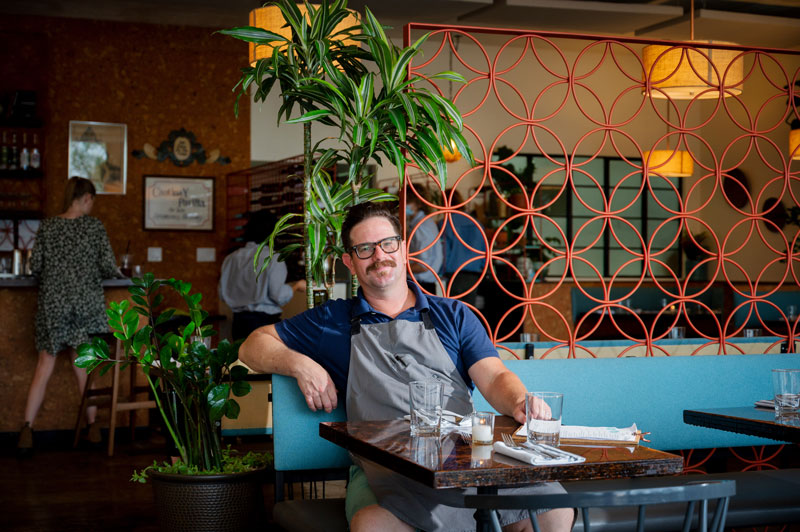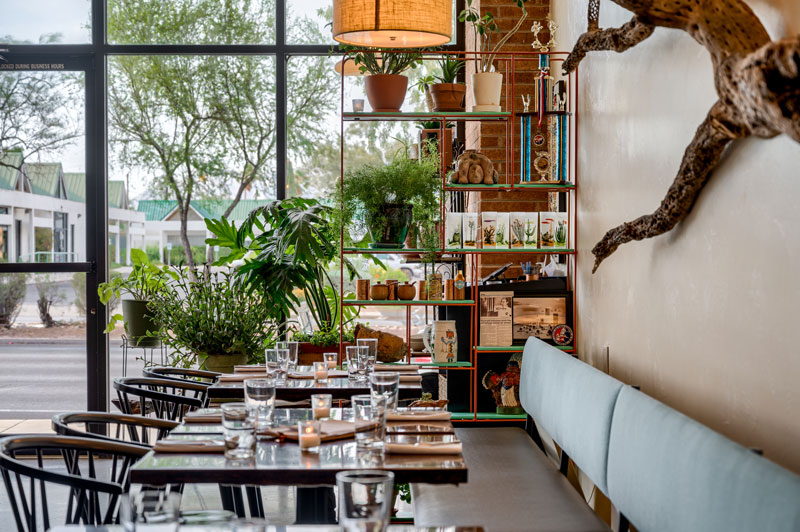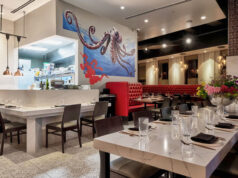The power of story and the love Chef/Owner John Martinez has for his grandmother, is exemplified in the name of his highly coveted midtown Tucson neighborhood bistro Tito & Pep. The fictional characters Tito & Pep and their adventures together were created by John’s grandmother and her best friend and first cousin, his Aunt Marie, while they were children growing up in post-war Los Angeles.
The actual stories of Tito & Pep, which embody the adventures of a rich Hispanic girl and a poor one, remain known only to the creators. John shares, ‘ Both these women are angels now. They’ve passed on. The stories are still just between them. They were Mexican-American girls growing up in East L.A. They were not wealthy by any means. But they were not paupers either. They had the good fortune of growing up with close families in an era where there was an equitable opportunity to support yourself even though there was a Depression. But if you worked hard, the government would also help to support you. The government felt a responsibility to fight against poverty. There was still a semblance of social responsibility.’
 Nostalgia-laced memories of fall season traditions pour out of John Martinez evoking idyllic familial images. He shares, ‘When you entered my grandmother’s home she was always roasting poblanos or chilies and cooking something delicious over the stove. She was a great cook. We always came together to make green corn tamales during the late summer harvest in the fall. The corn and the green chilies for the tamales would be harvested at the same time. We’d all meet up early in the morning. The corn would get shucked. You’d have to peel off the leaves carefully to get the whole husk to make the tamales. Those would get saved and washed. The kids would have to pick the silk out because we had the smallest fingers. We’d find little caterpillars in the corn and save them in a jar. That’d be what we get to play with. The kernels would be cut off the cobs and then they would go to the area to get ground for the masa. In the meantime, you’re cleaning the chilies. We’d have this assembly line running down two sides of a long table. As you grew you were at different areas of the table on the assembly line. The older uncles were always down at the end because they were the ones folding. My grandmother was always at the head. She would be the one that made the masa. I remember watching her hands, how she would hold them, whipping and folding in the masa and getting it nice and light.’
Nostalgia-laced memories of fall season traditions pour out of John Martinez evoking idyllic familial images. He shares, ‘When you entered my grandmother’s home she was always roasting poblanos or chilies and cooking something delicious over the stove. She was a great cook. We always came together to make green corn tamales during the late summer harvest in the fall. The corn and the green chilies for the tamales would be harvested at the same time. We’d all meet up early in the morning. The corn would get shucked. You’d have to peel off the leaves carefully to get the whole husk to make the tamales. Those would get saved and washed. The kids would have to pick the silk out because we had the smallest fingers. We’d find little caterpillars in the corn and save them in a jar. That’d be what we get to play with. The kernels would be cut off the cobs and then they would go to the area to get ground for the masa. In the meantime, you’re cleaning the chilies. We’d have this assembly line running down two sides of a long table. As you grew you were at different areas of the table on the assembly line. The older uncles were always down at the end because they were the ones folding. My grandmother was always at the head. She would be the one that made the masa. I remember watching her hands, how she would hold them, whipping and folding in the masa and getting it nice and light.’

 Martinez, who grew up in Tucson, but cut his culinary teeth in N.Y.C. under Jean-Georges Vongerichten, and held myriad chef positions around New York, has witnessed the booming growth of the gem desert city, as well as the evolution this has inspired gastronomically. John comments on regional culinary influences, ‘We are in this unique corner of the country, the original colonizing culture from the Spanish and from Mexico. This back and forth between Mexico and southern Arizona, between Sonora and southern Arizona culinarily and culturally, is something that resonates for a large part of the population. We need to embrace the culture that has existed here for centuries. This includes respecting the indigenous peoples that have been here for millennia, as well as embracing the Mexican-American culture that has been present here for hundreds of years as well.’
Martinez, who grew up in Tucson, but cut his culinary teeth in N.Y.C. under Jean-Georges Vongerichten, and held myriad chef positions around New York, has witnessed the booming growth of the gem desert city, as well as the evolution this has inspired gastronomically. John comments on regional culinary influences, ‘We are in this unique corner of the country, the original colonizing culture from the Spanish and from Mexico. This back and forth between Mexico and southern Arizona, between Sonora and southern Arizona culinarily and culturally, is something that resonates for a large part of the population. We need to embrace the culture that has existed here for centuries. This includes respecting the indigenous peoples that have been here for millennia, as well as embracing the Mexican-American culture that has been present here for hundreds of years as well.’
Echoing Martinez’s commitment to honoring ancestral cooking traditions, much of Tito & Pep’s innovative and culturally reflective menu centers around cooking over a mesquite grill. Martinez shares, ‘My family would always get together and cook over mesquite. You can’t do this in New York on your fire escape. The flavor that cooking over mesquite imparts is evocative of so many different cultures that go back forever and forever. Even if you cook up a pot of beans slowly over an open wood fire, that flavor and aroma finds its way into the beans. Getting the food over the mesquite is the one thing that continues to tie us to the culinary heritage of where we are.’
Like most chefs and restaurant owners, Martinez has a tale to tell regarding how Tito & Pep pivoted to survive during the pandemic. His story, in keeping with the Fall season edition, uniquely centers around his mesquite grill and turkeys. Martinez shares, ‘These past two Thanksgivings we sold whole turkeys cooked over mesquite with all of the sides. We built a 30 square -foot grill. We went from selling 20 to 30 then to 50 birds, and so on. This really helped us get over the hurdles of the Delta and Omicron
variants. People loved it because it was delicious and not
expensive, but for us, it was a lot of work, particularly with the sides. One turkey was dinner for 8 to 10
people, so in addition to the turkey, we were selling sides for hundreds of people. That was the insane part.’
Tito & Pep, with its accessible retro, mid-century aesthetic designed by Martinez’s wife, has won its success by the old-fashioned marketing tool of word of mouth. Having put zero dollars into advertising, Martinez has focused all his creativity and efforts on his menu and neighborhood-oriented service of his venue, an approach that is clearly working.
With culturally infused dishes such as grilled striped bass with mayakoba beans, zucchini, hoja santa, and lemon; grilled NY strip with roasted chilies, charro beans, and grilled onions; charred bean salad with labne, snap peas, pistachio, lemon, and fresh herbs, and crispy chicken torta with pickled onions, tomato, mint-lime mayo, to name just a few, Chef Martinez keeps it earthy, inviting and exotic at the same time.
Moving into fall, Martinez shares what he looks forward to creating for his seasonally inspired menus. ‘Fall in the desert means the chili harvest. Back to the conversation of tamales: it’s green corn, fresh corn, and green chili in September. I’ll also be adding a fall vegetable pasole with root vegetables to the menu. In December when we make our Christmas tamales, we’re using corn that was dried and externalized and then ground into the masa. Christmas tamales are with braised beef and dried red chilies. Sometimes I’m almost hesitant to put things that are so homey or simplistic on the menu. But when we do, people absolutely love it. Chilies are just so rooted here. Sometimes we’ll do them with brisket or a short rib or what have you. It is important to us to incorporate our cultural, local ingredients with the recipe and the traditional ways of cooking. This is honoring our people, our history, and our family. This is how I watched my father do it. This is how I watched my grandmother do it. And I want you to get that.’
















